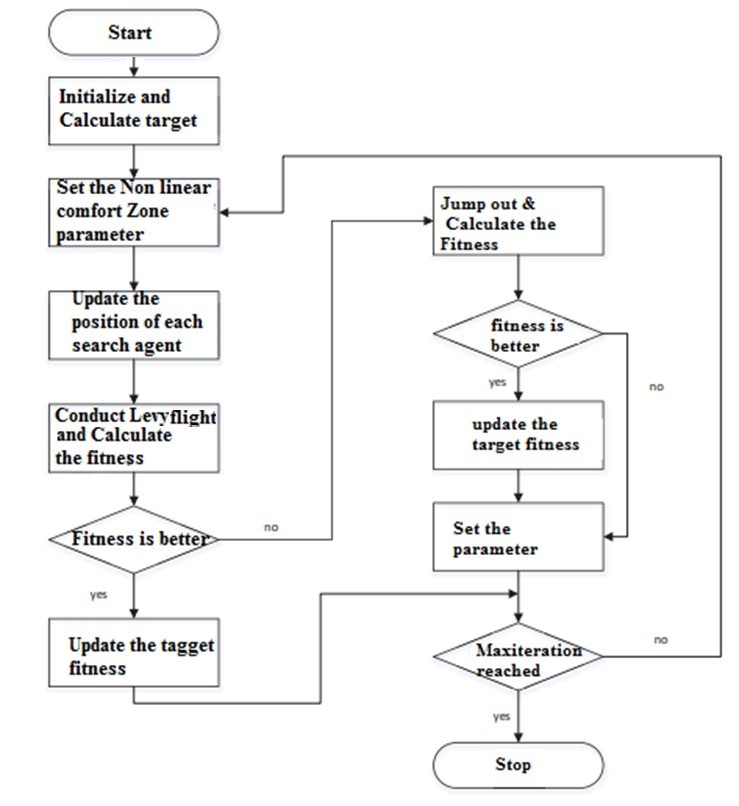Minimizing the Localization Error in Wireless Sensor Networks Using Multi-Objective Optimization Techniques
Main Article Content
Abstract
When it comes to remote sensing applications, wireless sensor networks (WSN) are crucial. Because of their small size, low cost, and ability to communicate with one another, sensors are finding more and more applications in a wide range of wireless technologies. The sensor network is the result of the fusion of microelectronic and electromechanical technologies. Through the localization procedure, the precise location of every network node can be determined. When trying to pinpoint the precise location of a node, a mobility anchor can be used in a helpful method known as mobility-assisted localization. In addition to improving route optimization for location-aware mobile nodes, the mobile anchor can do the same for stationary ones. This system proposes a multi-objective approach to minimizing the distance between the source and target nodes by employing the Dijkstra algorithm while avoiding obstacles. Both the Improved Grasshopper Optimization Algorithm (IGOA) and the Butterfly Optimization Algorithm (BOA) have been incorporated into multi-objective models for obstacle avoidance and route planning. Accuracy in localization is enhanced by the proposed system. Further, it decreases both localization errors and computation time when compared to the existing systems.
Article Details
References
Xiao, Shuo& Li, Tianxu& Tang, Chaogang& Cao, Yuan. (2019). Coverage Adaptive Optimization Algorithm of Static-Sensor Networks for Target Discovery. Chinese Journal of Electronics. 28. 398-403. 10.1049/cje.2018.02.009.
Xiao, Shuo& Li, Tianxu& Yan, Yan & Zhuang, Jiayu. (2019). Compressed sensing in wireless sensor networks under complex conditions of Internet of things. Cluster Computing. 22. 10.1007/s10586-018-2259-z.
Yedukondalu, Gangolu& K., Samunnisa &Bhavsingh, M. & Raghuram, I & Lavanya, Addepalli. (2022). MOCF: A Multi-Objective Clustering Framework using an Improved Particle Swarm Optimization Algorithm. International Journal on Recent and Innovation Trends in Computing and Communication. 10. 143-154. 10.17762/ijritcc.v10i10.5743.
Pasha, M. &Pingili, Madhavi & Sreenivasulu, K. & MALOTH, BHAV SINGH & Saheb, Shaik & Saleh, Alaa. (2022). Bug2 algorithm-based data fusion using mobile element for IoT-enabled wireless sensor networks. Measurement: Sensors. 24. 100548. 10.1016/j.measen.2022.100548.
Panwar, Anita & Kumar, Sh. (2012). Localization Schemes in Wireless Sensor Networks. Proceedings - 2012 2nd International Conference on Advanced Computing and Communication Technologies, ACCT 2012. 443-449. 10.1109/ACCT.2012.67.
M. R. Morelande, B. Moran and M. Brazil, "Bayesian node localisation in wireless sensor networks", Proc. IEEE Int. Conf. Acoust. Speech Signal Process., pp. 2545-2548, Mar. 2008.
C. Musso, N. Oudjane and F. Le Gland, "Improving regularised particle filters" in Sequential Monte Carlo Methods in Practice, Cham, Switzerland:Springer, pp. 247-271, 2001.
S. Gharghan, R. Nordin and M. Ismail, "A wireless sensor network with soft computing localization techniques for track cycling applications", Sensors, vol. 16, no. 8, pp. 1043, Aug. 2016.
H. Ahmadi and R. Bouallegue, "Exploiting machine learning strategies and RSSI for localization in wireless sensor networks: A survey", Proc. 13th Int. Wireless Commun. Mobile Comput. Conf. (IWCMC), pp. 1150-1154, Jun. 2017.
M. A. Bhatti, R. Riaz, S. S. Rizvi, S. Shokat, F. Riaz and S. J. Kwon, "Outlier detection in indoor localization and Internet of Things (IoT) using machine learning", J. Commun. Netw., vol. 22, no. 3, pp. 236-243, Jun. 2020.
L. Wang, M. J. Er and S. Zhang, "A kernel extreme learning machines algorithm for node localization in wireless sensor networks", IEEE Commun. Lett., vol. 24, no. 7, pp. 1433-1436, Jul. 2020.
Alrajeh, N.A., Bashir, M. and Shams, B. (2013) ‘Localization
techniques in wireless sensor networks’, International Journal of
Distributed Sensor Networks, Vol. 9, No. 6, pp.1–9.
Prasanna, CH.Harika (2015). Automatic and Systematic Methodology for Test Packet Generation. International Journal of Computer Engineering In Research Trends. 2(12),pp 1173-1177.
Coluccia, Angelo & Fascista, Alessio & Schumann, Arne & Sommer, Lars &Dimou, Anastasios &Zarpalas, Dimitrios& Méndez, Miguel &Iglesia, David & González, Iago & Mercier, Jean-Philippe &Gagné, Guillaume & Mitra, Arka&Rajashekar, Shobha. (2021). Drone vs. Bird Detection: Deep Learning Algorithms and Results from a Grand Challenge. Sensors. 21. 2824. 10.3390/s21082824.
L.Sravanthi,B.RanjithKumar(2015). A Survey on Fault Identification Using Automatic Test Packet Generation .International Journal of Computer Engineering In Research Trends. 2(10),pp 871-874.
SHAHID, Muhammad & MALIK, Tahir & SAID, Ahsan. (2021). Heuristic based binary grasshopper optimization algorithm to solve unit commitment problem. TURKISH JOURNAL OF ELECTRICAL ENGINEERING & COMPUTER SCIENCES. 29. 944-961. 10.3906/elk-2004-144.
Arora, Sankalap & Singh, Satvir. (2016). An Improved Butterfly Optimization Algorithm for Global Optimization. Advanced Science, Engineering and Medicine. 8. 711-717. 10.1166/asem.2016.1904.
Kaushik, Abhinesh & Lobiyal, Daya. (2021). Localization in Wireless Sensor Networks Using a Mobile Anchor and Subordinate Nodes. 10.1007/978-981-33-6173-7_12.

